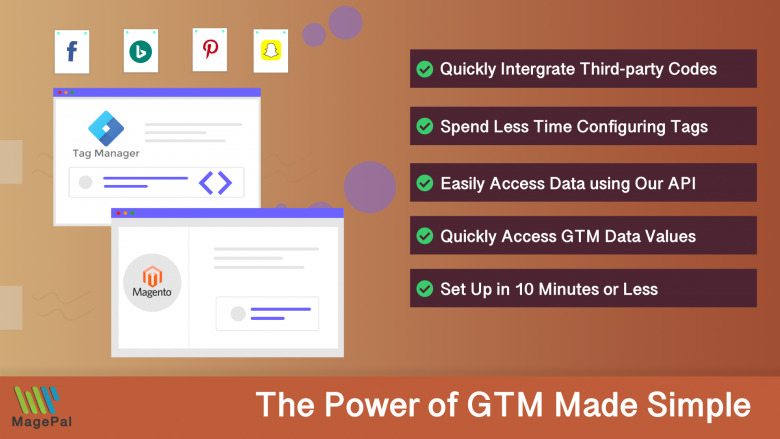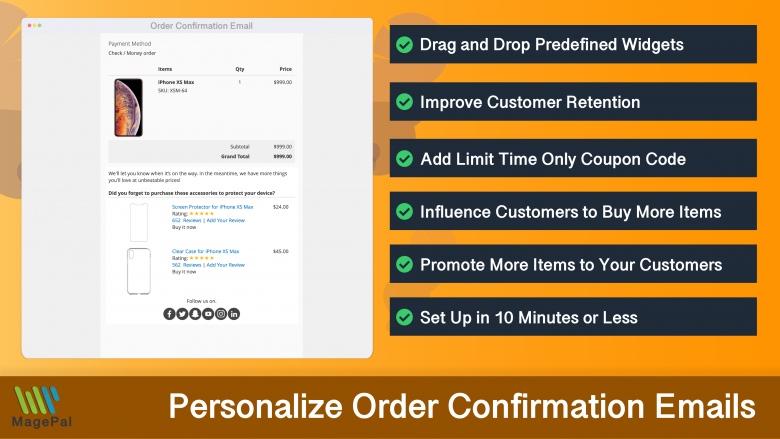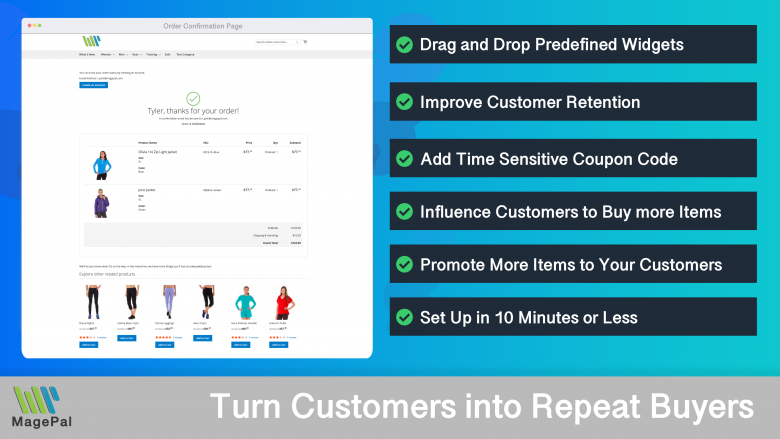Push the limits of your Adobe Commerce store with MagePal Extension
Take your Adobe Commerce store to new heights with the power of MagePal extensions. Our expertly crafted code and rigorous testing ensure seamless integration with Adobe Commerce, giving you the freedom to focus on growing your business, not debugging. Upgrade your store's potential with MagePal.
How to Drive More Traffic to Your Magento Store using Paid Ads.
Paid advertising can be a powerful tool for increasing website traffic, particularly in the short term. In today’s digital landscape, paid advertising has become an essential tool for driving traffic to your Magento ecommerce website. However, simply running ads is not enough. To get the best results from your paid advertising efforts, you need to have a well-planned strategy and the right tracking tools to measure the effectiveness of your campaigns. In this blog, we’ll take a look at how you can increase your traffic with paid ads in Magento ecommerce and the ways to track your ads campaigns.
Determine your target audience:
To increase your traffic with paid ads, the first step is to determine your target audience. You can use Google Analytics to analyze your website traffic and gain insights into your audience’s demographics, interests, and behaviors. This information can help you create ads that are more relevant and engaging to your target audience.
Choose the right ad platform:
There are several ad platforms available, including Google Ads, Facebook Ads, and Instagram Ads. You should choose the platform that best suits your target audience and the nature of your business. For example, if you are selling B2B products, LinkedIn Ads may be a better choice than Facebook Ads.
Create compelling ads:
To attract clicks and conversions, your ads need to be eye-catching, informative, and relevant. Your ad copy and visuals should reflect your brand and highlight your unique selling proposition (USP). You can also use A/B testing to determine which ad creatives perform the best.
Set your budget and bidding strategy:
It’s essential to set a realistic budget for your ads campaign. You should also determine your bidding strategy, which can be either cost per click (CPC) or cost per impression (CPM). Your bidding strategy will depend on your campaign objectives and the ad platform you choose.
Use relevant keywords:
Using the right keywords is crucial to the success of your ads campaign. You can use tools like Google Keyword Planner or SEMrush to research the keywords your target audience is searching for. Use these keywords in your ad copy and target them with relevant ad groups.
Track your ads campaign:
To track the performance of your ads campaign, you need to use tracking tools like Google Analytics or Facebook Pixel. These tools allow you to monitor your ad spend, measure your click-through rate (CTR), and track your conversions. You can use this data to refine your ads campaign and optimize your budget.
Here are 10 frequently asked questions about increasing traffic with paid ads for Magento ecommerce:
How much should I spend on my ads campaign?
The amount you spend on your ads campaign depends on your budget and your campaign goals. It’s important to set a realistic budget that won’t drain your finances, but is also enough to drive meaningful traffic to your site.
Which ad platforms should I use for my Magento store?
The ad platform you choose will depend on your target audience and your business goals. Some popular options for ecommerce stores include Google Ads, Facebook Ads, and Instagram Ads.
How can I target my ads to the right audience?
To target your ads to the right audience, use tools like Google Analytics to gain insights into your website traffic and use the data to create custom audiences on your ad platform.
How can I optimize my ad copy and visuals for maximum impact?
Make sure your ad copy and visuals are eye-catching, informative, and relevant to your target audience. Use A/B testing to determine which ad creatives perform the best and make adjustments accordingly.
What is a bidding strategy and how do I choose one?
A bidding strategy is how you determine the amount you are willing to pay for a click or impression. Your bidding strategy will depend on your campaign objectives and the ad platform you choose.
How do I know if my ads campaign is successful?
You can track the performance of your ads campaign using tools like Google Analytics or Facebook Pixel. Monitor your ad spend, measure your click-through rate (CTR), and track your conversions to refine your campaign and optimize your budget.
Can I target specific keywords with my ads?
Yes, you can use tools like Google Keyword Planner or SEMrush to research the keywords your target audience is searching for and use these keywords in your ad copy and target them with relevant ad groups.
What is retargeting and how can it help me increase traffic?
Retargeting is a strategy where you target ads to people who have already visited your website. This helps to increase brand awareness and encourages them to return to your site.
Should I use video ads for my ecommerce store?
Video ads can be a great way to showcase your products and engage with your target audience. Consider using video ads on platforms like YouTube or Facebook.
How can I ensure my ads are compliant with ad policies?
Make sure you review the ad policies of the ad platform you are using to ensure your ads are compliant. Avoid using misleading or offensive content and ensure your ads meet the platform’s guidelines.
Paid advertising can be an effective way to increase your traffic with Magento ecommerce. However, it’s essential to have a well-planned strategy, create compelling ads, use relevant keywords, and track your campaign’s performance. By following these steps, you can ensure that your paid advertising efforts yield the best results and drive more traffic to your Magento ecommerce website.
Magento 2 / Adobe Commerce Extensions
0
Total Downloads
11
years experience with Magento
30+
Magento / Adobe Commerce Extensions
Shop with confidence
With millions of downloads worldwide, install with confidence knowing that our extensions will just work.
Learn More About MagePal Extension
Is your Magento store ready for the future? Say hello to the new Google Analytics 4, which is built from the ground up with all-new features and advanced machine learning technology.
Related
- How to Add Google Analytics to Magento
- How To Prevent Magento Email From Being Marked As Spam
- Unlock the Full Potential of Your Hyvä Theme with MagePal's Google Tag Manager and Analytics Extension
- Magento and GDPR: Magento + GDPR + GA4
- Maximize Your E-commerce Data with MagePal's Google Tag Manager and Analytics Extension for Magento 2
- Why Upgrading to GA4 with Magento and Adobe Commerce is a Must
- Master Magento/Adobe Analytics: Optimize your eCommerce store
- The Importance of Adding a Newsletter Popup to Your Magento Store
- Proven Strategies to Increase Your Magento Sales
- Google Analytics 4 Extension for Magento 2
- Using Google Tag Manager and Magento to track conversions
- Upgrade to Google Analytics 4: A Step-by-Step Magento Guide
- Is Magento the Best E-commerce Platform for Your Business? Find out Now!
- Unlock the Power of GTM with Custom DataLayer
- Using Google Analytics and Magento to Optimize Your eCommerce Store
- Cheap Email marketing strategy for Magento
- Cost-effective email marketing for Magento
- How to Add Google Ads Enhanced Conversion Data to Magento / Adobe Commerce with MagePal Datalayer Extension
- Best Google Tag Manager Extension for Magento 2
- Best Magento 2 Google Analytics 4 Extension
- The Ultimate Guide to the Best Magento 2 SMTP Extensions
- Does Magento 2 Support Google Analytics 4?
- Exploring the Exciting New Features of Google Analytics 4 (GA4) for Magento Ecommerce
- How to Integrate TikTok Tracking Pixel with Magento 2 using Google Tag Manager
- The Benefits of Integrating Magento and Google Tag Manager
- How to Enhance Your Magento Store's Shipping Experience
- Magento and Google Tag Manager (GTM) FAQ - Key Questions Answered
- Magento 2 Google Tag Manager (GTM) Extension
- The Benefits of Integrating Magento and Google Tag Manager for E-commerce Success
- Boosting Your Magento Newsletter Conversion and Subscription Rate: Tips and Strategies
- Convincing Customers to Subscribe to Your Magento Newsletter: Tips and Strategies
- Maximize E-commerce Insights with Magento, GTM & GA4 Integration
- How to Setup Google Adwords (Google Ads) Conversion Tracking in Magento 2
- Understanding the Importance of a Data Layer in Google Tag Manager
- How to Improve Your Magento Sales with an Affiliate Program
- Implementing Facebook Pixel on Magento 2 with GTM Extension
- Best Practices for Using Affiliate Programs to Drive Traffic
- Drive More Sales to Your Magento & Adobe Commerce Site with Affiliate Programs
- Improve Magento Ads Conversion with GA4 and Google Ads Enhanced Conversion
- How Google Analytics 4 Can Enhance Your Google Ads Campaign
- How to Add a Social Sharing Block to Your Magento 2
- Unlocking the Secrets to Successful Magento SEO: Tips and Strategies
- Revolutionize Your Magento SEO with GA4 - Here's How!
- Socialize your Sales: Creative Ways to Boost Your Magento eCommerce with Social Media
- TikTok and Magento: The Ultimate Power Couple for eCommerce Success
Magento 2 Extensions
Get ahead of the competition with MagePal Magento 2 extensions - Unlock new opportunities and drive more sales.
DataLayer for Tag Manager
Whether you are integrating Bing, Facebook, SnapChat, Pinterest, or any other services our extension make it easy.
Enhanced Transactional Emails
Get more from your order confirmation emails by promoting other complementary products.
Enhanced Success Page
Add cross-sell, upsell, related products, social media links and other elements to your order confirmation.


